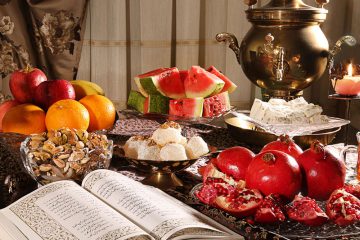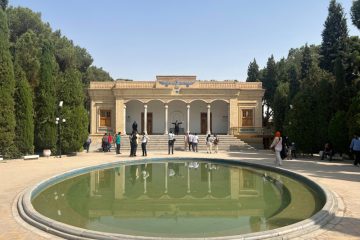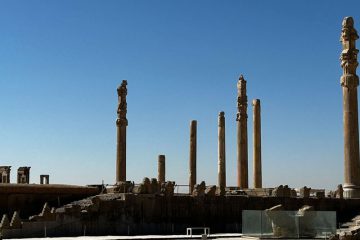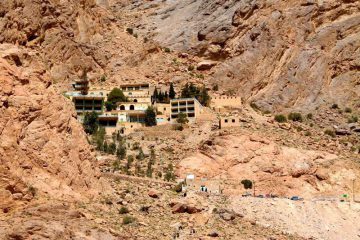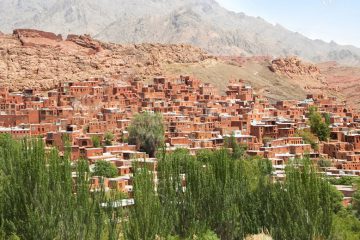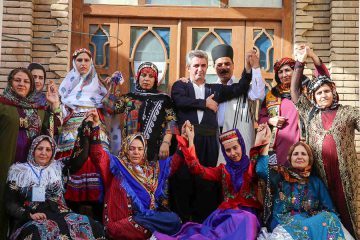
Iranian Ceremonies: A Journey Through Time
Iranian Ceremonies: Have you ever dreamed of traveling back in time, immersing yourself in the rich tapestry of ancient traditions? Iran, a land known for its storied history, offers an extraordinary opportunity to experience the magic of its ancient ceremonies. These rituals, deeply rooted in the cultural heritage of the Persian people, provide a window into the past that’s as captivating as it is enlightening. Join us on a journey as we explore the vivid world of Iranian ancient ceremonies, each a vibrant thread in the fabric of history.
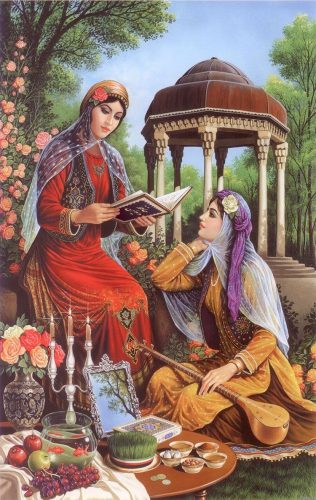
Persian New Year Ceremony: Nowruz
As spring arrives and nature starts to bloom, Iranians celebrate Nowruz, the Persian New Year. This age-old tradition marks the start of spring and the fresh start of life. Let’s take a peek at what Nowruz involves:
Iranian celebration of rebirth and renewal
Nowruz, meaning “new day,” symbolizes the eternal cycle of life, death, and rebirth. Iranians embrace this occasion as a chance to let go of the old and welcome the new.
Rituals and Customs of Nowruz
- Spring cleaning: Homes are thoroughly cleaned to rid them of negativity and make way for positivity in the coming year. Chaharshanbe Suri: On the eve of the last Wednesday of the year, bonfires are lit, and people jump over the flames to ward off bad luck.
- Haft-Seen Table: This iconic display features seven items starting with the Persian letter “S,” each representing a different aspect of life and nature.
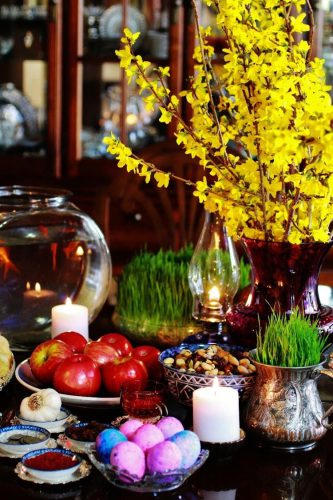
Nowruz Haft-Seen Table: A feast for the senses
Behold the Haft-Seen Table, an exquisite arrangement that’s as visually pleasing as it is meaningful:
- Sabzeh: Sprouted wheat, symbolizing rebirth.
- Samanu: A sweet pudding representing power and strength.
- Senjed: Dried oleaster fruit for love and compassion.
- Seer: Garlic cloves for medicine and health.
- Seeb: Apples symbolize beauty and good health.
- Somāq: Sumac berries for the sunrise and patience.
- Serkeh: Vinegar, signifying aging and patience.
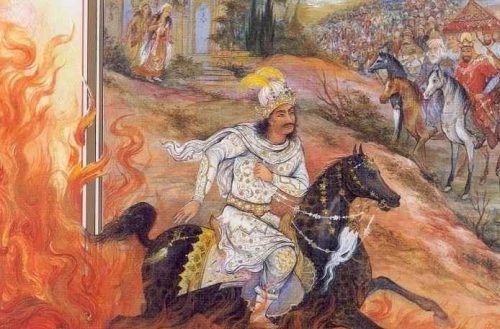
Iranian Fire Festival: The mesmerizing Chaharshanbe Suri
Join the fiery revelry of Chaharshanbe Suri, a night of jumping over bonfires and welcoming the new year with a blaze of positive energy.
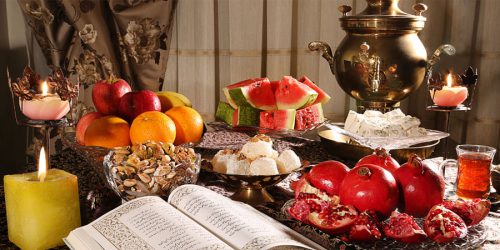
Yalda Night: Embracing the Winter Solstice in Iranian Ceremonies
As the longest night of the year descends upon Iran, the warmth of human connection and ancient beliefs shines bright during Yalda Night.
Welcoming the longest night of the year
Yalda, or Shab-e Yalda, is a celebration of light conquering darkness, a night when families and friends gather to embrace the coziness of the season.
Pomegranates and watermelon: Symbolism on your plate
Pomegranate: A symbol of life, rebirth, and the cycle of nature.
Watermelon: A reminder of summer’s bounty, keeping the hope of warmer days alive
Storytelling and staying up all night: yalda’s unique charm
In this Iranian Ceremony Gather around as old stories are shared, laughter resonates, and spirits are lifted to honor the power of storytelling and togetherness.
The science behind yalda’s traditions
Discover the astronomical significance of Yalda Night in Iranian Ceremonies, rooted in the winter solstice, and how it reflects humanity’s deep connection to the cosmos.
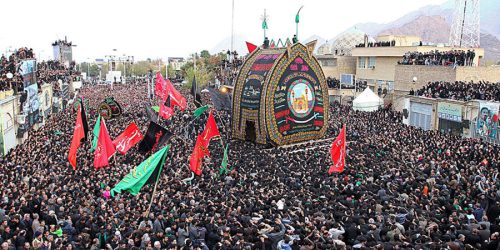
Mourning of Ashura: Commemorating with Passion
The Mourning of Ashura is a poignant commemoration that echoes through time, evoking the spirit of sacrifice and resilience.
A solemn event with deep historical roots
Ashura is a day of mourning in remembrance of the tragic events at Karbala, a battle that marked the martyrdom of Imam Hussein, the grandson of the Prophet Muhammad.
The story of Imam Hussein and its significance
Delve into the tale of Imam Hussein’s unwavering stand against injustice and tyranny, a story that continues to inspire millions around the world.
Matam: Expressing grief through rhythmic rituals
Witness the fervent rituals of matam, where mourners engage in rhythmic chest-beating as a physical manifestation of grief and devotion.
Nazri: Feeding the mourners and fostering community
Experience the heartwarming tradition of nazri, where volunteers offer free food and drinks to mourners, epitomizing the spirit of selflessness and unity.
Sadeh: Kindling the Flames of Antiquity in Iranian Ceremonies
Sadeh, a festival of fire and light, ignites the spirit of unity and warmth during the chilly days of winter.
Honoring fire and warmth in the heart of winter
Sadeh celebrates fire as a symbol of light, energy, and vitality, bringing people together to embrace the warmth of the community.
Zoroastrian origins of Sadeh celebrations
Uncover the Zoroastrian roots of Sadeh and how it seamlessly merged with Persian culture, creating a vibrant festival that transcends religious boundaries.
Bonfires and feasting: Sadeh’s lively traditions
Partake in the jubilant atmosphere of Sadeh as bonfires illuminate the night and feasting fosters camaraderie among family, friends, and strangers.
Cultural influences and contemporary adaptations
Explore how Sadeh has evolved, blending ancient customs with modern sensibilities while retaining its essence of spreading joy and connection.
Tirgan Festival: Dancing by the Water in Persian Ceremonies
Tirgan, a jubilant celebration of water, rain, and river goddesses, beckons people to join in merriment by the shores.
Paying homage to rain and river goddesses in Iranian Ceremonies
In Iranian Ceremonies, Tirgan celebrates the power of water and its life-giving force with rituals dedicated to the goddess Anahita, the ancient Persian deity of fertility and water.
The joyful spirit of Tirgan celebrations
Immerse yourself in the contagious joy of Tirgan, marked by music, dance, games, and a sense of unity that transcends age, gender, and background.
Traditional music, dance, and vibrant costumes
Witness the enchanting performances of traditional Iranian music and dance, accompanied by colorful costumes that tell their own stories.
Water battles and merrymaking: A wet and wild festivity
Engage in the exhilarating tradition of water fights during Tirgan, where participants playfully drench each other, fostering a spirit of play and camaraderie.
Iranian Ceremonies: Conclusion
Embarking on a journey through the ancient Iranian ceremonies is akin to traversing a portal to a time long gone. These rituals, each with its unique symbolism and significance, offer an opportunity to bridge the gap between the past and the present.
Our cultural tours within Tours of Iran are designed to give you the perfect opportunity to deeply engage with Iranian ceremonies and traditions. We can enhance our grasp of human history and culture by participating in these ceremonies and delving into their origins and meanings. While the world progresses swiftly, these timeless traditions act as grounding forces, underscoring the significance of our heritage and the need to safeguard the intangible aspects that mold our identities. For an enriched experience, travel with tours of Iran to fully immerse yourself in the richness of Iranian ceremonies.

